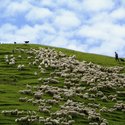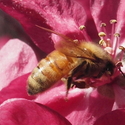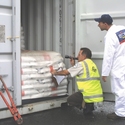American foulbrood (AFB) is a highly infectious1 disease2 that infects bee larvae3. It costs the beekeeping industry millions of dollars a year and threatens the role of bees as pollinators. DownUnder Honey, in partnership with dog trainer Pete Gifford and Massey University researchers, is developing a scientific methodology to train dogs to reliably detect the disease.
American foulbrood
American foulbrood (AFB) is caused by spore-producing bacteria4 Paenibacillus larvae. The spores5 can survive for decades in soil. The spore has a tough outer layer that makes it difficult to kill – it can survive many disinfectants and boiling water. Beekeeping equipment from infected hives needs to be autoclaved at 160°C for 12 minutes to kill the spores.
Controlling AFB
In New Zealand, control of the disease depends on self-detection and reporting – a legal requirement for all beehive owners. Detection relies primarily on visual assessment. This means early infections6 and spores can be overlooked. The Management Agency National American Foulbrood Pest Management Plan audits7 hives where hotspots of disease are reported. An audit8 inspection is time consuming. It involves taking a hive apart to look at all the frames and components. This means fewer than 0.5% of hives are audited annually. The possibility of a dog trained to detect AFB would make a significant difference to the management of AFB. A reliable detection dog could easily inspect every apiary in an area like Wairarapa within a week.
AFB spores are also in honey boxes that are randomly put out in the field every year and may have come off an infected colony spreading the disease. A dog would also be able to detect spores in these boxes before they were deployed9.
Reliability and repeatable results from dog detection are important to bring beekeepers on board and to pay for dog training and implementation.
Dog detection methods aren’t new, but to date, they have been unreliable with a lot of false positives. One of the reasons behind this is that these detector dogs were trained to detect stress10 pheromones or decomposing larvae. Honeybees emit stress hormones11 for many different stressors, including varroa, and decaying larvae could be attributed to a number of issues.
Why dogs?
Dogs are frequently used by people to ‘sniff out’ diseases12 and pests. They’re also employed to detect bombs, help in search and rescue or disaster situations or to detect drugs, plants and foods being brought into a country illegally.
There are many physiological13 reasons why a dog is such an excellent sniffer. A dog nose has a larger surface area14 of olfactory15 epithelium16 (tissue inside the nose cavity) than a human. This means that dogs have around 300 million smell receptor cells (depending on the dog breed) to only around 6 million in humans.
Lots of animals have a remarkable sense of smell – the elephant is said to have the best – but dogs have the added advantage of being a domesticated animal. Could you imagine training an elephant to detect disease?! As domesticated animals, dogs work well with people, and we can utilise their desire to please us and their natural play behaviour and prey drive17.
The team
Highly experienced in breeding and training detection dogs, Pete Gifford has worked with search and rescue organisations, Corrections services and the military. He has trained dogs to detect everything from tobacco and drugs to humans with early-stage cancers and other diseases.
One day when picking up a foster dog, Pete was asked if he could train a dog to detect AFB. From here Pete was introduced to beekeeper Jason Prior at DownUnder Honey.
It all started with a conversation between a man who knew nothing about bees and beekeeping and a man who knew nothing about training detector dogs.
Pete Gifford, K9 Search Medical Detection
Together, the men received funding for training and trialling a new dog detection method. To assure a rigorous approach with reliable results that beekeepers and regulatory bodies could trust, they teamed up with Massey University veterinary science researcher Dr Neroli Thomson, who developed the scientific methodology, ran the trials and is the lead author on the end research report, and Plant and Food Research apicultural scientist Michelle Taylor, who cultured the AFB spores for the ‘target odour’ samples.
Pure odours
The trials used a sterile18 and pure AFB target odour to train and test the dogs. This pure odour is an important point of difference. It means the dogs were trained to only detect the actual AFB bacteria.
Pete explains that pure odours present interesting challenges. “When we smell a roast cooking, we smell Sunday dinner, whereas a dog breaks everything down and can smell the meat, the fat, the carrots, the potatoes, the roasting pan.” This meant an initial training phase had to involve desensitising the dogs to odours associated with the AFB target odour delivery that wouldn’t be encountered in beehives – for example, the flask and saline solution it came in.
Project phases
Pete started with four dogs he identified as having the drive and disposition for the work at hand. “It’s all about their play and prey drive,” he says. Alongside his standard training room, Pete set up a cleanroom with a multi-bucket carousel for the volatile19 organic compounds20 – the odour samples. The cleanroom enables testing without contamination21 odour issues and was used for the trials in the final phase.
Pete started with training the dogs to systematically check for scents in a series of boxes in his standard training room, and in the second phase, he selected the two best dogs to continue with the AFB samples in the cleanroom.
Final testing trials were conducted so that both Pete and the dogs did not know where the sample was within the carousel. Dog trainers can unconsciously signal to their dogs where a sample is, so blind testing is vital. All trials were recorded with a CCTV set-up.
Both dogs achieved a perfect score in the final trials, which suggests the dogs could indeed recognise an odour from P. larvae spore samples. Dr Neroli Thomson says, “For each dog, the probability of this result occurring by chance alone is very small – less than 0.1%.”
The next step will be trials involving real hives on location in the beekeeping industry.
Related content
Understand the importance of honey bees in ecosystems22 in Honey bee heroes and read about the work to combat another bee pest – the varroa mite.
The Buzz of bees is a Connected journal devoted entirely to bees. A variety of articles cover topics such as adaptation23, threats, pollination24 and beehive technology.
Learn about the sense of smell in humans.
American foulbrood disease arrived in New Zealand in 1877 – 38 years after honey bees were introduced. Teach and learn about biosecurity – the process of detecting and controlling unwanted crop weeds, pests and diseases, including detection of new threats coming into New Zealand.
See the range of interesting resources in our Dogs, cats and science Pinterest board.
Useful links
The Management Agency National American Foulbrood Pest Management Plan aims to eliminate American foulbrood in managed colonies (beehives) in New Zealand. The Management Agency website has extensive resources on AFB management, identification and regulatory requirements.
Apiarist’s Advocate is an e-magazine that provides the beekeeping industry with news, views and promotions. Read its update on this project in the article Passing the sniff test.
Many dogs have jobs – find out more about the Ministry for Primary Industries Detector Dog Programme and follow a typical detector dog’s day. Dogs have also been long established as detectors for conservation25 work – read the New Zealand Geographic article Track and trace.
In the easy to read article Dogs’ Dazzling Sense of Smell, learn about the biology and aerodynamics of the dog nose
Acknowledgement
This resource is adapted from the article by Rural Delivery, a television programme that looks at excellence and innovation26 within the primary industries27 in New Zealand. The Science Learning Hub acknowledges Showdown Productions for the use of this article and the accompanying video clip.
- infectious: An infection that quickly spreads.
- diseases: 1. An abnormal condition of an organism that impairs bodily functions. 2. In plants, an abnormal condition that interferes with vital physiological processes.
- larva: An immature form that some animals (such as insects, crustaceans and amphibians) pass through before metamorphosing into an adult form.
- bacteria: (Singular: bacterium) Single-celled microorganisms that have no nucleus.
- spores: Small reproductive structures that can grow into a new individual. Produced by ferns, fungi, and some algae and protozoans. In bacteria, spores are different – they form in some bacteria in unfavourable conditions, protecting the bacteria from environmental harm.
- infection: Invasion of the body or a species by something that could be harmful or cause a disease.
- audit: Inspection.
- audit: Inspection.
- deployed: Placed or moved into position.
- stress: In mechanics, a force applied to a body.
In ecology and physiology, a response to a stimulus, e.g. an environmental factor, that disturbs or interferes with the normal equilibrium. - hormone: A chemical substance secreted by an endocrine gland into the bloodstream. It acts on specific target cells to produce a given response to control and regulate the activity of certain cells or organs.
- diseases: 1. An abnormal condition of an organism that impairs bodily functions. 2. In plants, an abnormal condition that interferes with vital physiological processes.
- physiological: The function of organs and organ systems and how they work within a living organism to respond to external and internal challenges.
- surface area: The total area of an object or surface.
- olfactory: Relating to the sense of smell.
- epithelium: Tissue or cells that cover external and internal body surfaces, for example skin cells and cells that line the stomach.
- prey drive: The instinctive urge of a carnivorous animal to find, chase and capture prey.
- sterile: Free from contaminating organisms, like bacteria or viruses, that may transmit disease.
- volatile: Easily evaporates or turns into a gas; used in everyday language to mean something that changes quickly.
- organic compounds: Substances based on a carbon framework. They vary greatly in size and complexity and contain other elements, most commonly hydrogen and oxygen.
- contamination: The introduction of contaminants into a substance.
- ecosystem: An interacting system including the biological, physical, and chemical relationships between a community of organisms and the environment they live in.
- adaptation: A change in the structure or function of something. In biology, a change in a species, as a result of natural selection. Individuals with a particular feature (adaptation) are more likely to survive and reproduce than individuals without this feature.
- pollination: The transfer of pollen grains from the anther to the part of the plant containing the ovules. This process is necessary for fertilisation and reproduction of the plant.
- conservation: The protection, preservation and careful management of a species, habitat, artifact or taonga.
- Innovation: The development of a new process or product that is then used by others.
- primary industry: This umbrella term refers to industries that are making direct use of natural resources. Primary industries in New Zealand include agriculture, horticulture, aquaculture, forestry and mining.











